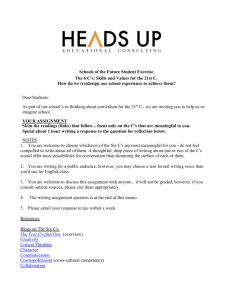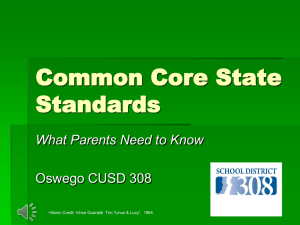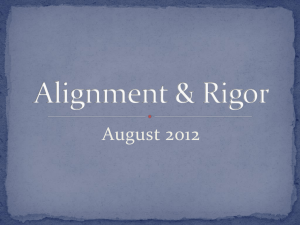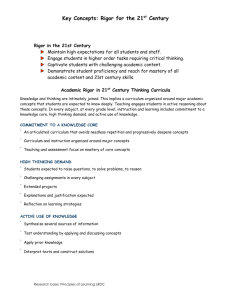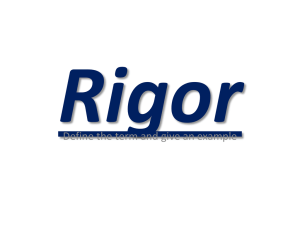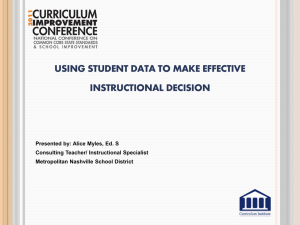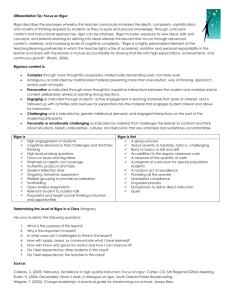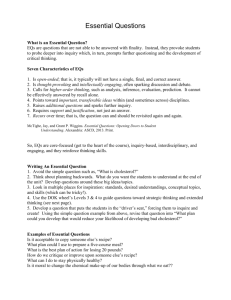Increasing Rigor to Develop Critical Thinking Skills
advertisement
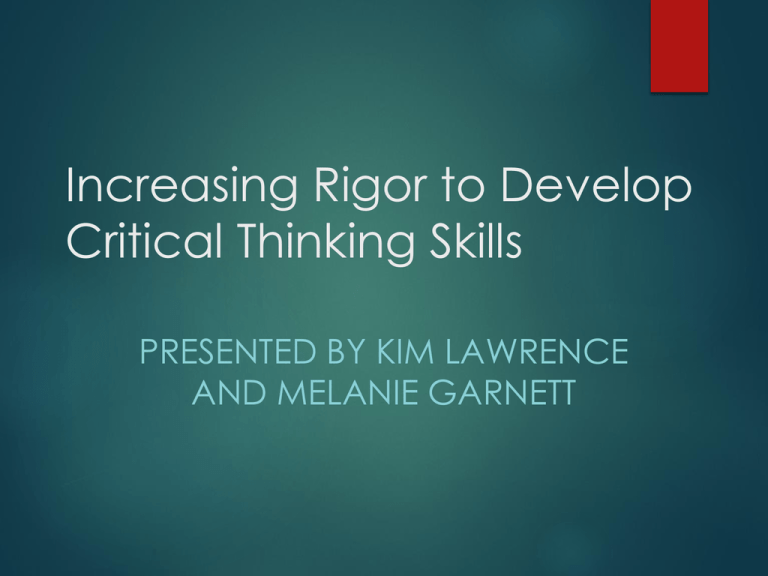
Increasing Rigor to Develop Critical Thinking Skills PRESENTED BY KIM LAWRENCE AND MELANIE GARNETT Find Someone Who… Let’s get to know each other a little! Rigor-the latest cliche A search for “rigor” on the VDOE site returned 974 hits A search for “rigorous” on the VDOE site returned 1,470 hits Rigor-the latest cliche The word “rigorous” appears 16 times in the U.S. Department of Education Document “A Blueprint for Reform” Rigorous Standards Rigorous Assessments Rigorous Interventions (The word America appears 9 times) What is rigor? With a team of 2 or 3 discuss the following: What is RIGOR? What does RIGOR look like in the classroom? Why is it important? How do you implement it? Construct a poster using your creativity Rigorous Learning Experience Non-rigorous Learning Experiences Many Definitions of Rigor Rigor requires active participation from both teachers and students. Rigor asks students to use content to solve complex problem and to develop strategies that can be applied to other situations, make connections across content areas, and ultimately draw conclusions and create solutions on their own Many Definitions of Rigor Rigor requires teachers to create a learning environment where students use their knowledge to create meaning for a broader purpose Rigor requires students to learn how to develop alternative strategies if their first attempts are unsuccessful OLD SOL Question NEW SOL Question-More Rigorous!!! Comprehensive interpretation of SOL and Curriculum Framework SOL 3.11 The student willa) tell time to the nearest minute, using analog and digital clocks; and b) determine elapsed time in one-hour increments over a 12hour period. Under Essential Knowledge and Skills, the third bullet says: When given the beginning time and ending time, determine the elapsed time in one-hour increments within a 12-hour period (times do not cross between a.m. and p.m.). There are three elements in this type of problem: a beginning time, an ending time, and the amount of time that has elapsed. If given ANY two of these three elements, the students should be able to find the missing piece. Additional Ways for Students to Demonstrate Understanding Addition of non-multiple choice items called technology-enhanced items (TEI): Fill-in-the-blank Drag and drop Hot-spot: Select one or more “zones/spots” to respond to a test item; i.e. select answer option(s), shade region(s), place point(s) on a grid or number line Creation of bar graphs/histograms BREAK! How Can Teachers Achieve and Maintain Instructional “Rigor”? Engage students in the learning process, providing relevant activities and tasks that require a high level of cognitive demand Ask high-leverage questions that require students to think, process, and communicate Require students to justify their thinking and reasoning Math Rigor Provide instruction that requires students to become mathematical problem solvers that communicate mathematically; reason mathematically; make mathematical connections; and use mathematical representations to model and interpret practical situations Reading Rigor Standards at each grade address reading fiction and nonfiction Nonfiction emphasizes text structures and organizational patterns Inferences and conclusions based on explicit and implied information Differentiate between fact and opinion Increase rigor by choice of texts Offer students choice in reading/writing topics Use project-based learning Use cooperative groups Evidence of Rigor Students not only learn, do, and reflect. They also master skills such as: Critical thinking, Problem solving, Creativity, Collaboration, Project management, and Written and oral communication. 21st century skills are embedded in all of the above! Examples from L.A. Take a look at the vertical alignment of the Reading Comprehension SOLs for grades K-2 Read excerpt about the Gradual Release of Responsibility Video of a Teacher Think-Aloud http://www.youtube.com/watch?v=00-i6m8ELiw Share examples of rigorous comprehension instruction Examples from Math Take a look at the vertical alignment of the math SOLs for grades K-2 Read the “Rigor in Mathematics Teaching and Learning” article Share examples of rigorous math instruction Time for you to work Now we are going to give you more time to explore: Professional books Blackboard site VDOE website (Enhanced Scope and Sequence) Number/Number Sense Module How do you plan on incorporating more rigor to your math and/or reading instruction?
